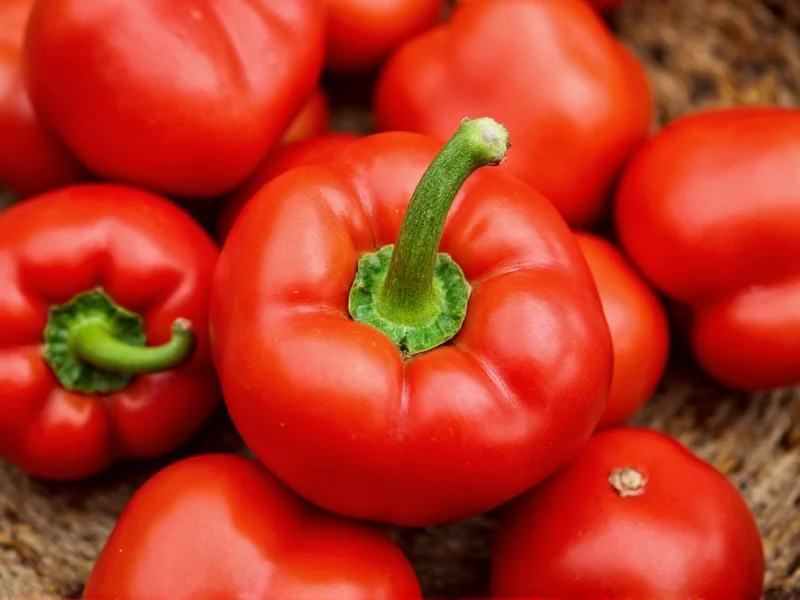Paprika's vibrant color and distinctive flavor have made it a kitchen staple worldwide, but many home cooks wonder about its exact composition. This versatile spice originates from Central America but gained prominence in Hungarian and Spanish cuisines, where traditional production methods have been perfected over centuries. Understanding what paprika is made from helps consumers select the right variety for their culinary needs and recognize authentic products versus adulterated versions.
The Pepper Varieties Behind Paprika
While all paprika comes from Capsicum annuum peppers, specific cultivars determine the final product's characteristics. Hungarian paprika typically uses Kurri, Komáromi, and Erdőszíjas varieties, while Spanish paprika (pimentón) relies on Ónati, Bola, and Choricero peppers. These regional differences in paprika ingredients create distinct flavor profiles that influence traditional dishes.
Traditional Paprika Production Process
The journey from pepper to paprika involves several critical steps that preserve flavor and color:
| Production Stage | Traditional Method | Impact on Final Product |
|---|---|---|
| Harvesting | Peppers picked at peak ripeness (deep red/orange) | Maximizes color compounds and flavor development |
| Drying | Sun-dried or smoked over oak/beechnut wood | Smoking creates distinctive pimentón de la Vera; sun-drying preserves natural sweetness |
| Processing | Seeds and stems removed before grinding | Prevents bitterness; ensures smooth texture |
| Grinding | Stone mills at low temperatures | Preserves volatile oils and color compounds |
Different Types of Paprika and Their Composition
Not all paprika is created equal. The specific peppers used and production methods determine the final classification:
- Sweet Paprika – Made from mild, sweet pepper varieties with no capsaicin heat. Contains only ground pepper fruit with no additives.
- Hot Paprika – Includes hotter pepper varieties or incorporates some seeds/membranes containing capsaicin.
- Smoked Paprika (Pimentón) – Made from peppers smoked over wood fires for 10-15 days, creating complex flavor compounds.
- Sweet Hungarian Paprika – Protected designation requiring specific Hungarian pepper varieties and production methods.
What Pure Paprika Does NOT Contain
Authentic paprika contains only ground peppers, but some commercial products may include:
- Rice flour or other fillers (common in lower-quality products)
- Salt (in paprika blends, not pure paprika)
- Artificial colors (like Red 40) to enhance appearance
- Anti-caking agents (silicon dioxide)
When examining paprika ingredients, pure varieties should list only “ground peppers” or “paprika.” Products labeled “paprika seasoning” often contain additional ingredients. Understanding what paprika is made from helps avoid products with unnecessary additives that dilute flavor and color.
How to Identify High-Quality Paprika
Quality paprika shows these characteristics:
- Vibrant red-orange color that stains fingers slightly when touched
- Fragrant aroma with no musty or dusty smells
- Smooth texture without gritty particles
- Single-ingredient listing on packaging
- Regional designation (Hungarian, Spanish La Vera, etc.) indicating traditional production
Proper storage in airtight containers away from light preserves paprika's volatile compounds. Quality paprika maintains its color and flavor for 6-12 months, while inferior products containing fillers may separate or lose potency more quickly. Knowing what authentic paprika is made from helps consumers recognize when they're getting a pure, high-quality product.
Common Misconceptions About Paprika Composition
Several myths persist about paprika ingredients:
- Myth: Paprika contains tomato powder to enhance color
Fact: Pure paprika gets its color naturally from carotenoids in peppers; no tomatoes are used - Myth: All paprika is spicy
Fact: Sweet paprika varieties contain zero capsaicin and are completely mild - Myth: Paprika is a blend of multiple spices
Fact: Authentic paprika contains only ground peppers; spice blends containing paprika are different products
Using Paprika Effectively in Cooking
Different paprika types serve distinct culinary purposes based on their composition:
- Sweet paprika enhances color in dishes like deviled eggs and potato salad without adding heat
- Hot paprika provides gentle warmth to stews and meat rubs
- Smoked paprika adds depth to bean dishes, barbecue sauces, and roasted vegetables
- Hungarian paprika is essential for authentic goulash and chicken paprikash
For maximum flavor impact, add paprika toward the end of cooking or bloom it in oil first to release its aromatic compounds. Understanding what paprika is made from helps cooks select the right variety for each application and avoid heat levels that might overpower a dish.
Is paprika made from only peppers or does it contain other ingredients?
Pure paprika contains only dried and ground peppers with no additional ingredients. Authentic paprika lists a single ingredient: ground peppers or paprika. Some commercial products labeled as “paprika seasoning” may contain salt, fillers, or anti-caking agents, but these are not pure paprika.
What gives paprika its distinctive red color?
Paprika's vibrant red color comes naturally from carotenoid pigments in the peppers, particularly capsanthin and capsorubin. These compounds develop as the peppers ripen to deep red or orange. No artificial colors are needed in authentic paprika production.
How is smoked paprika different from regular paprika?
Smoked paprika (pimentón) is made by smoking the peppers over oak or beech wood for 10-15 days before grinding, which infuses the peppers with distinctive flavor compounds. Regular paprika is typically sun-dried. This smoking process creates a complex, woodsy flavor profile not found in standard paprika varieties.
Can paprika contain artificial additives?
Authentic, high-quality paprika contains no artificial additives. However, some lower-quality commercial products may include anti-caking agents like silicon dioxide, fillers such as rice flour, or artificial colors like Red 40 to enhance appearance. Always check the ingredients list for pure paprika products.
Why do some paprikas taste sweet while others are hot?
The heat level in paprika depends on the pepper variety used and which parts of the pepper are included. Sweet paprika comes from mild pepper varieties with seeds and membranes removed (where capsaicin concentrates). Hot paprika uses hotter pepper varieties or includes some seeds/membranes containing capsaicin, the compound responsible for heat in peppers.











 浙公网安备
33010002000092号
浙公网安备
33010002000092号 浙B2-20120091-4
浙B2-20120091-4